
Jan '06 - Jan '07
I haven't posted in a while so I'll try to catch up on everything as quickly as possible.
Teaching is going well so far. We are concentrating on techniques in Photoshop for designing web pages, and we are going to move into web programming with style sheets next week.
I'm taking the second semester studio as an elective with Taeg Nishimoto, and we are working on the ACSA AISC competition to design a community aquatic center. We had our "second" review today, if you will, and mine didn't go over so well. My project in a nutshell is to treat the building as a body of water, and the users of the building as "particles" inside a body of water, constantly being bombarded by molecules, and thus being subjected to "brownian motion."
Brownian motion is basically way to describe how particles suspended in a body of water are in constant "random" motion. Seeing as how I have to use Maya in all my other classes at the Viz Lab, I decided to write a program that simulates this phenomenon by drawing a "random walk" path based on some number of t steps. Anyways, I'll cut to the chase: here are some images I have come up with so far: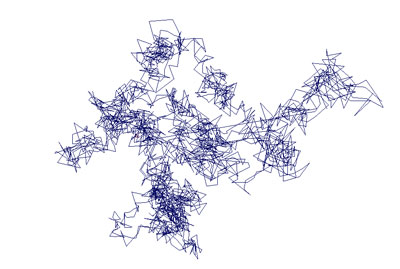
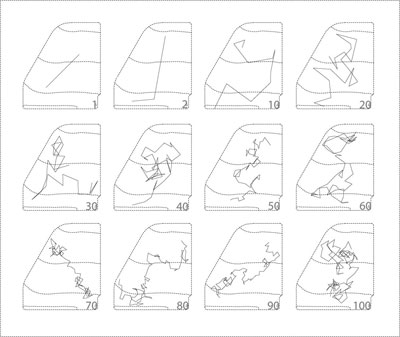

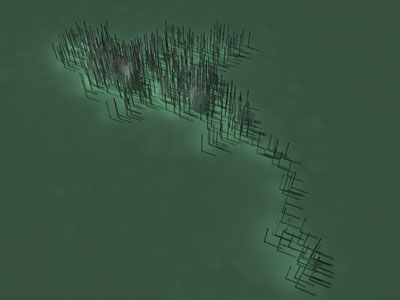
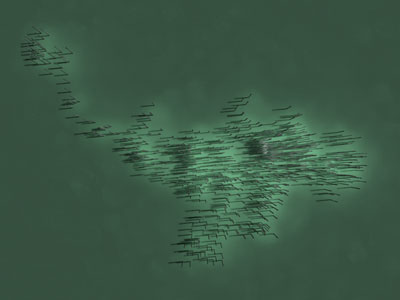
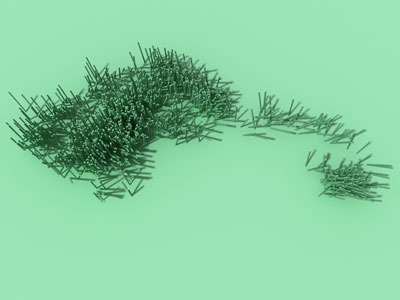
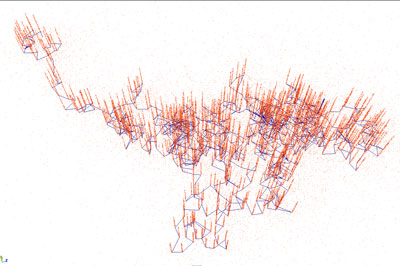
the idea there is to treat this random path as either circulation space in the context of a building, or as points on which to impose some obstruction in the physical space, like a structural support column.
After that really led me to some kind of a dead end, I decided to start thinking about creative ways to use steel and how to express it in this building. I have been playing around with polygon and nurbs modeling in maya rather than spending time cutting out matte board in the studio, and this is some of the stuff I came up with.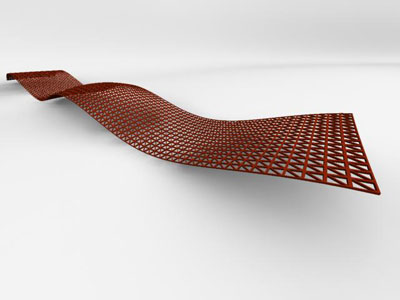

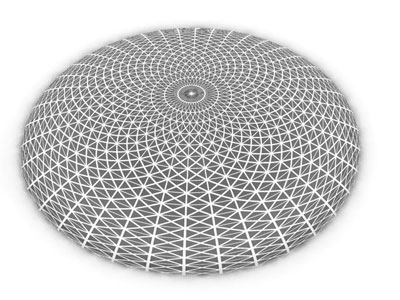
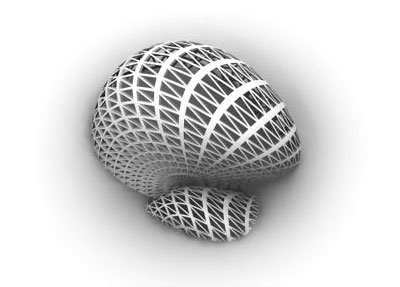


My favorite so far is the tube, but I have only been working on this since last night, so I'm sure i'll come up with something a little nicer...
Please let me know what you think... more to come later tonight.
13 Comments
david, are those models created using MEL scripting or are they transparancy mapping upon the surfaces? Looks neat!
the first set of images is all pure mel script, and the second set of images is all poly models with default lambert shaders, rendered with mental ray / final gather / ibl
I figured out that "trick" if you will with the poly models to create a quick space frame structure, and just went crazy from there...
cool... i kinda thought it was that from the shadows it created.. Reason I ask is becasue I am currently taking a scripting course where we will be attempting to write scripts that create similar effects in structural form. Sounds like you know how to write script....any advice?
yeah, i am learning mel slowly but surely. there are some guys in the lab here who blow me away with the stuff they do, but most of them concentrate on procedural shaders rather than procedural modeling.
my advice can be summed up in a few websites and tips:
http://www.ewertb.com/maya/mel/mel.php?howto=01
http://forums.cgsociety.org/showthread.php?t=203074
http://www.ewertb.com/maya/mel/mel.php?howto=03
http://www.robthebloke.org/
that last one is great. he just has a lot of code samples... other than that i read the help file all the time just scrubbing to find key words and syntax hints.
what course is it you are taking, and at what school? that sounds like a cool class. something that A&M needs very badly. the students in the mArch program are often devoid of technical knowledge that it's hard to present my ideas and get constructive feedback.
Thanks, I am attending the Product Architecture Lab at Stevens Institute of Technology. I am actually writing and much needed post update as we speak. The course is called: Programming for Design Applications. It is basically a course we demanded to be created for us after seeing some of the work being created by those who know scritping in the year above us. While not always as pretty as the maya renderings...the scripts they write generate form in CATIA which is then subject to structural analysis and optimization. Its gonna be a pretty amazing yet difficult course. We try to avoid the Columbia model of taking random scripts and generating form from it with no real logic....or being post rationalized.
I'll check out the links... i have found some rhino script which i have been running then trying to decipher the code so i can then eventually write my own if need be.
thanks
wow, that's awesome. I have not used catia, but it looks like it would be really helpful for this project I am working on right now. I know what you mean about the Columbia approach. my prof used to teach at Columbia, and he is sort of straying me away from that line of thinking.
what kind of forms do you generate in catia? do you ever use mathematica as well?
CATIA is a parametric modeling software. They use it primarly in the automotive and aerospace industries. It is a extremely robust software but it isnot for the feint of heart. Its not an easy program to learn and not a real great quick design tool. Its made for manufacturing not for image/animation creation.
You can create anything that can be manufactured in CATIA. In that respect, it often wont let you create surfaces that fold in on themselves aka (create a cusp) since this cant be manufactured. There are ways around it since you and i know that you can manufacture it in components. But initally if your surface creates a cusp it gives you an error. CATIA is not as facile a modelling software as maya or rhino.
I have never used mathematica..is it like MATlab?
yeah, the way i understand it, mathematica is a kind of subset of matLab, but it's its own program as well, produced by wolfram research... it has some amazing functionality for creating complex graphs and parametric surfaces, etc...
I will have to check out catia some time. thanks for telling me about it.
I'm teaching an undergraduate course in the architecture department, and I'm trying to get my students exposed to as many different types of software as possible, if only to know that they exist. i'm always looking for new tools... well, new to me i guess in the case of catia. i heard a story from my prof that one of the developers of catia became a project manager for the guggenheim or disney concert hall when gehry's firm was having trouble using the software, or something to that effect.
additionally, the full version of catia has its own FEA module. to run analysis on the models. Or the model can be imprted into a more powerful FEA software like ANSYS
However, catia is not a rendering sofware so the stuff you get out looks kinda cartoony.
Come to think of it, a program like Generative Components from Bentley may be well suited to your needs. Try to get you hands on a copy. Its not a renderer either but it does some sick shit. Its in Beta so i believe it may be free if you can find where to get it.
i read somewhere that bentley just purchased ramint, a big structural steel design software package...
i have always wanted to have a discussion about this, but i haven't ever found anyone around here who has used bentley... why does bentley insist on having the most counter-intuitive user-interface design, and how on earth do they compete with autoDesk anything (besides the price)?
i'll have to look at generative components... never heard of it...
That story about gehry does not surprise me.. But yes, gehry does us Digital Project which is his modified version of CATIA. But they have an inhouse staff (gehry Tech) that does much of the programming and i believe all the modelling. I can see that story being true for the gughenheim ...but i think they have things under control with the software for the disney project. We have a good relationship with Gehry Tech here at Stevens. We too use DIgital Project, some of my classmates worked for GT last year as interns. Some of which may be asked to come back.. i'm not sure.
i havent used microstation in a long time .. but i liked it when i used it.. probably becasue it was the first cad program i knew fluently. Interesting about them purchasing ramint. I was recetnly using ETABS, another FEA structural software specifically for buildings, for my studio project. I am guessing Ramint is similar.
I'll have to find the email, but my classmate recently sent me a link to a FEA plugin for MAYA. Probably not too acurate but still kinda cool.
Generative Components interface is i think somehow linked with microstation but its a parametric software unlike the regular microstation. Definatelyw worth check ing out. Our Director and 4 of my classmates are actually in Cambridge England now for the SmartGeometry Conference hosted by Generative COmponents. SOunds like fun.
If you need any advice on software for your studio just ask.. It seems we are learning or being introduced to every software package under the sun here.
awesome, man. you have no idea how much i appreciate this... if only i could get my hands on generative components, i can't seem to find it.
Block this user
Are you sure you want to block this user and hide all related comments throughout the site?
Archinect
This is your first comment on Archinect. Your comment will be visible once approved.